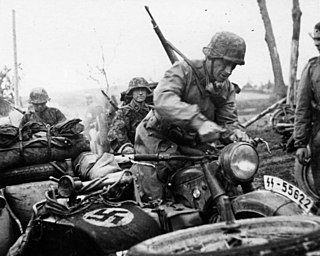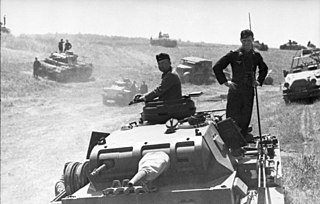
The Waffen-SS was the military branch of the Nazi Party's SS organisation. Its formations included men from Nazi Germany, along with volunteers and conscripts from both occupied and unoccupied lands.

The Panzergrenadier Division "Großdeutschland" was an elite combat unit of the German Army (Heer) that fought on the Eastern Front in World War II.

The 1st SS Panzer Division "Leibstandarte SS Adolf Hitler", short LSSAH, (German: 1. SS-Panzerdivision "Leibstandarte SS Adolf Hitler") began as Adolf Hitler's personal bodyguard, responsible for guarding the Führer's person, offices, and residences. Initially the size of a regiment, the LSSAH eventually grew into an elite division-sized unit during World War II.

The 1st Panzer-Division was an armoured division in the German Army, the Wehrmacht, during World War II.
The Fallschirm-Panzer-Division 1. Hermann Göring was an elite German Luftwaffe armoured division. The HG saw action in North Africa, Sicily, Italy and on the Eastern Front. The division began as a battalion-sized police unit in 1933. Over time it grew into a regiment, brigade, division, and finally was combined with the Parachute-Panzer Division 2 Hermann Göring on May 1, 1944 to form a Panzer corps under the by then Reichsmarschall. It surrendered to the Soviet Army near Dresden on May 8, 1945.

The 13th Panzer Division was an armoured division in the German Army, the Wehrmacht, during World War II, established in 1940.
The 21st Panzer Division was a German armoured division best known for its role in the battles of the North African Campaign from 1941–1943 during World War II when it was one of the two armoured divisions making up the Deutsches Afrikakorps (DAK).

The 29th Infantry Division was a unit of the German army created in the fall of 1936. It was based on the old Reichswehr 15th Infantry Regiment and drew its initial recruits from Thuringia. It was upgraded to 29th Motorized Infantry Division in the fall of 1937. The division was also known as the Falke-Division.

The 8th Panzer Division was a formation of the WehrmachtHeer. The division was formed by reorganising the 3rd Light Division in January 1940. It was transferred to the west and fought in the Battle of France, in May 1940, and the German invasion of the Balkans in April 1941. Soon after the division advanced towards Leningrad under Army Group North in Operation Barbarossa, and would remain on the eastern front for the remainder of the war. Staying on defensive fronts, it saw action in the relief of Kholm in 1942, Orel and the withdrawals of Army Group Centre in 1943, until transferred to Army group South. The division then fought in a series of retrograde movements, back through the Ukraine, into Hungary and finally into Silesia and surrender in May 1945.

The 9th Panzer Division was a panzer division of the Wehrmacht Army during World War II. It came into existence after 4th Light Division was reorganized in January 1940. The division was headquartered in Vienna, in the German military district Wehrkreis XVII.

This is a sub-article to Battle of Narva (1944).

The 44th Infantry Division was formed on 1 April 1938 in Vienna, about two weeks after the Anschluss of Austria. It first saw combat at the start of the war in the Invasion of Poland, and also took part in the Battle of France in 1940. After a 9-month period of coastal defence the division was transferred East. On 22 June 1941, the division took part in the invasion of the Soviet Union, attached to Army Group South. It remained in the east after the failure of "Operation Barbarossa", taking part in defensive actions for the winter against the Soviet Army offensives near Izum and Kharkov. Refurbished, the division participated in the German summer offensive, and was subsequently destroyed with the 6th Army at Stalingrad in January 1943.
The 19th Panzer Division was an armoured division in the German Army, the Wehrmacht, during World War II. It was created from the 19th Infantry Division.

The 25th Infantry Division was a military unit of the German Wehrmacht. It was later reclassified to 25th Infantry Division (mot.), and in June 1943 to the 25th Panzer Grenadier Division.

The 15th Infantry Division was an infantry division of the German Army during the interwar period and World War II, active from 1934 to 1945.

The 31st Infantry Division was a German infantry division of the Army during World War II. It participated in the invasion of Poland in 1939 then the invasion of France and the Low Countries in 1940. As part of Panzergruppe 2. of Army Group Centre, it was involved in the invasion of the Soviet Union in June 1941. After hard fighting throughout 1941 and 1942 it joined the 9th Army and fought in the Battle of Kursk in July and August 1943. Along with the rest of the 9th Army, the division conducted a fighting withdrawal for the remainder of 1943, during which it sustained heavy casualties. In the early stages of the Soviet Operation Bagration of June to August 1944, the 31st Infantry Division was destroyed, a fate which subsequently befell most of Army Group Centre. The division was officially disbanded on 18 July 1944.

15th Panzergrenadier Division was a mobile division of the German Army in World War II

The 258th Infantry Division was an infantry unit of the German Army in World War II.
The 549th Volksgrenadier Division was a volksgrenadier infantry division of the German Army during World War II, active from 1944 to 1945. It was formed as the 549th Grenadier Division in July 1944 and became a volksgrenadier division several months later. Fighting on the Eastern Front, it was nearly destroyed in the East Prussian Offensive, with its remnants retreating west and surrendering to American troops at the end of the war.
The 252nd Infantry Division was an infantry division of the German Heer during World War II.















